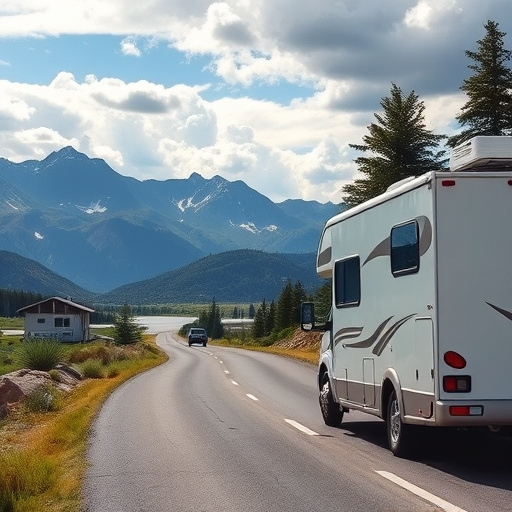RV tire pressure monitoring systems (TPMS) are essential tools for RVing for Beginners and experienced travelers, offering enhanced safety and peace of mind. These systems continuously monitor tire pressure, alerting drivers to underinflation or overinflation, which can affect handling, fuel efficiency, and tire longevity. For beginners, understanding and utilizing TPMS is crucial to prevent issues like blowouts and reduce accident risks. Regular checks ensure optimal tire pressure for a smoother journey and prolonged tire life. Modern RVs with built-in TPMS facilitate safe travel practices, making it a game-changer for both newcomers and seasoned RVers.
For RVing beginners or seasoned pros, tire pressure monitoring is a crucial aspect of safety that often goes overlooked. Understanding RV tire pressure monitoring systems can significantly enhance your travel experience. This article delves into the mechanics behind these systems, revealing how correct tire inflation impacts RV safety. We’ll also explore common challenges and provide best practices for regular checks, ensuring a smooth and secure journey. Finally, discover advanced monitoring features that take RVing to the next level.
- Understanding RV Tire Pressure Monitoring Systems
- The Impact of Correct Tire Inflation on RV Safety
- Common Challenges in Maintaining RV Tire Pressure
- Best Practices for Regular Checks and Maintenance
- Enhancing Your RVing Experience with Advanced Monitoring Features
Understanding RV Tire Pressure Monitoring Systems

RV tire pressure monitoring systems are a game-changer for RVing for beginners and experienced travelers alike. These innovative technologies are designed to ensure optimal tire performance and safety by constantly keeping an eye on each tire’s air pressure. They work by utilizing sensors that detect any variations in pressure, sending real-time data to a control module. This module then alerts the driver if any tire is underinflated or overinflated, which can significantly impact handling, fuel efficiency, and tire longevity.
For RVing for beginners, understanding these systems is crucial as they help prevent common issues like blowouts and reduce the risk of accidents. By maintaining the recommended tire pressure, drivers can enhance their overall travel experience, ensuring a smooth journey and peace of mind while on the road. This simple yet effective safety practice allows RV owners to focus on enjoying their trip rather than worrying about potential hazards related to underinflated tires.
The Impact of Correct Tire Inflation on RV Safety

Maintaining proper RV tire pressure is a crucial aspect of safe RVing for beginners and seasoned travelers alike. Under-inflated tires can significantly impact handling, stability, and overall control while driving. This is especially true for larger vehicles like RVs, which have unique tire requirements due to their size and weight. Correct inflation ensures each tire functions optimally, reducing the risk of blowouts, skidding, or loss of control in various road conditions.
For RV owners, regularly checking tire pressure can prevent accidents and extend tire lifespan. Many modern RVs come equipped with built-in tire pressure monitoring systems (TPMS), which alert drivers when pressure drops below recommended levels. This technology is a game-changer for safety, allowing RVers to take prompt action, ensuring their vehicle’s tires are inflated correctly before hitting the road.
Common Challenges in Maintaining RV Tire Pressure

For RV owners and those new to RVing, maintaining proper tire pressure can be a common challenge. With larger tires designed for off-road adventures and frequent use on varied terrain, keeping track of individual tire pressures is often overlooked. Many beginners might not realize that underinflated or overinflated tires can lead to serious safety hazards while on the road.
In the excitement of hitting the open road, regular checks can be missed, especially when navigating different climates and altitudes. Extreme temperatures can cause rapid changes in tire pressure, making it crucial for RVers to stay vigilant. Fortunately, with modern technology, many RVs now come equipped with built-in tire pressure monitoring systems (TPMS), providing real-time alerts and data to ensure safe travel practices for both seasoned and novice RV owners.
Best Practices for Regular Checks and Maintenance

For RV owners and those new to RVing for Beginners, establishing a consistent routine for tire pressure checks is paramount. It’s recommended to verify pressure at least once a week, or before every trip, using a reliable gauge. This simple practice can prevent unexpected issues on the road. A steady air pressure ensures optimal performance, fuel efficiency, and most importantly, enhances safety by reducing the risk of tire failure.
Proper maintenance involves keeping an eye on any unusual changes in pressure during usage. Regular rotation of tires is also crucial to distribute wear evenly, further prolonging their lifespan. By combining these best practices with timely checks, RV owners can confidently hit the open road, knowing their vehicles are in top condition, thereby enhancing overall travel safety.
Enhancing Your RVing Experience with Advanced Monitoring Features

For RVing for beginners or seasoned veterans, incorporating advanced monitoring features can significantly enhance the overall experience. Modern RVs are now equipped with tire pressure monitoring systems (TPMS) that provide real-time data on each tire’s pressure. This innovative technology is a game-changer when it comes to safety and convenience. By ensuring optimal tire pressure, you not only improve fuel efficiency but also maximize the lifespan of your tires.
For RV owners, these monitoring systems offer peace of mind while on the road. They alert drivers to any significant pressure drops, allowing for immediate action to prevent flats or accidents. This proactive approach is especially crucial when navigating diverse terrains, ensuring a smooth and worry-free journey for both experienced RVers and those new to the sport.
RV tire pressure monitoring systems are a game-changer for RVing, offering enhanced safety practices that benefit both seasoned and beginner travelers. By understanding these systems, maintaining correct inflation levels, and adopting best practices for regular checks, RV owners can ensure smoother journeys and mitigate potential hazards on the road. Embracing advanced monitoring features further improves the overall RVing experience, allowing you to focus more on exploring new places with peace of mind.
